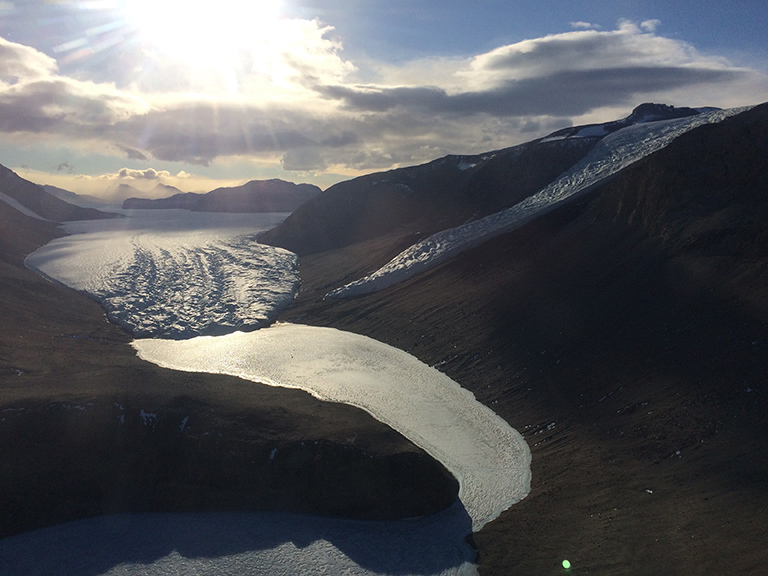Ask NASA Climate | February 8, 2016, 20:46 PST
The real ice sheets of Antarctica

The terminus of Taylor Glacier as seen from the helicopter. Photo by P. Neff.
“I’m looking at 10 glaciers and I’m sitting on one,” said Dr. Heidi Roop of the University of Rochester over satellite phone. “I’m looking at a landscape that’s been here for millions of years unaltered by people.” Roop had called me from Taylor Glacier, an outflow of the East Antarctic Ice Sheet, which flows down through Antarctica’s McMurdo Dry Valleys. I’m looking at a mountain that no human has ever touched, ever. This is a landscape where it feels like humans shouldn’t be. There are no animal trails, no trees. There’s rock and ice and us.”
Roop and the rest of the eight-person team, which included one driller, two scientists, three Ph.D. candidates and a camp cook/manager, had come to drill for ice cores at Taylor Glacier because of its unique configuration. Drilling ice cores is a technique climate scientists use to collect samples of trace gases such as carbon dioxide, methane and carbon monoxide that have been trapped in air bubbles in the layers of polar ice.
Scientists drilling for ice cores head to Antarctica because it’s the cleanest place on the planet. (There’s so much more pollution and dust in the Northern Hemisphere.) “We’re not studying Antarctica itself, although Antarctica is a huge player in the global climate system," Neff said. "But rather we’re learning things about global climate that we can learn only in Antarctica. It’s so far away, yet it holds clues that inform our understanding of the rest of the world.”
Traveling back in time
Taylor Glacier is an unusual place on a continent that’s full of the unusual, which is why this group of scientists traveled there. The glacier flow has essentially tipped ice layers on their sides, so to travel back in time the team can simply walk across the glacier instead of having to drill deep down. Time is stretched out north to south, so “as you walk northward you’re going forward in time, from ice that’s 80,000 years old, past the coldest part of the last glacial period 20,000 years ago (when it was so cold and dry there was less vegetation, so the atmosphere was dusty), all the way to ice that’s only 8,000 years old,” Neff explained. The team also took their Ski-Doo down the glacier about 10 kilometers to a site where they previously found 125,000 to 130,000 year old ice, which formed during the last interglacial period—the last time global climate was close to today’s warm temperatures. Other ice core records suggest that this time period was actually several degrees warmer than today, making it our best analogue for the warm conditions we’re headed towards.
24 hours of daylight
Although there is 24 hours of daylight during the summer in Antarctica, the drill team wakes up in the middle of the night when the sun moves behind a mountain range and creates a shadow for about five hours. “The sun just does a big circle around us, but the shadow makes it a lot colder, which keeps the drill from freezing into the glacier,” Neff explained. Then Roop added, “When the sun goes behind the mountain, the glacier crackles and pops—loud pops like gunshots—because of the temperature drop.”
Once they collect the ice cores, some are put into a pressure chamber under vacuum to remove all the modern air and are then melted. The gas from the ancient bubbles is released as the ice cores melt, and then gets carefully pulled into sample canisters, which are about the size of a SCUBA tank.
The National Science Foundation has a Presidential mandate to manage the U.S. Antarctic Program, under which it supports researchers, coordinates all U.S. science on the southernmost continent and in the surrounding ocean, and provides the infrastructure and logistical support needed to make the science possible.
Find out more about the University of Rochester Ice Core Expedition here.
Thank you for reading.
Laura
